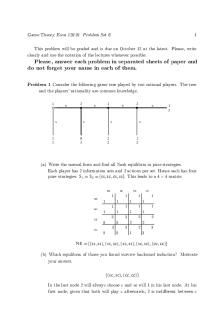PS 1 Solutions PDF

| Title | PS 1 Solutions |
|---|---|
| Course | Macroeconomía Avanzada I |
| Institution | Universitat Pompeu Fabra |
| Pages | 4 |
| File Size | 612.3 KB |
| File Type | |
| Total Downloads | 48 |
| Total Views | 134 |
Summary
Soluciones seminario...
Description
Advanced Macroeconomics I,UPF Professor Andrea Caggese PROBLEM SET 1-suggested answers to selected problems
1. A)
¶y 2 = ¶k 3
-1 / 3
B)Plugging in numbers for k we find for the MPK: 2/3 (k=1), 0.53 (k=2) and 0.46 (k=3). C)Take derivative of MPK w.r.t. k to see that MPK is decreasing in k.
D)
¶2y 2 = - k 4 / 3 < 0 2 ¶k 9
¶ p 3 -1 / 4 = p= k 1 / 2 ¶y 4 . First replace y via the production function . It follows then that
¶ p 1 = ¶k 2
-1 / 2
.
1 ¶ p = - -3 / 2 2 4 ¶k 2
E)Second derivative is negative so profits are decreasing in k,
2
•
¶ln X (t ) X (t ) Make use of = X (t ) ¶t A and B) When we are interested in variables that grow over time, it is more natural to work with the (natural) logarithm of these variables, especially when growth is approximately constant. This is for the simple reason that (as you have seen in 1.2.A) when Z(t) grows at a constant rate ln Z(t ) grows linearly, and (as you can convince yourself) if Y(t) and Z(t) ( Y (t ) ¹ Z(t ) grow at the same proportional rate, ln Y (t) - ln Z(t )is constant, while Y(t ) - Z(t )is not. D In every case, just take logs and differentiate with respect to time at both sides of the equation using the provided basic properties of the logarithm.
3 •
•
•
A)! Given that k (t) = −7 + 2k(t), k (t ) = 0 if and only if k(t)=7/2. Any higher k will cause k (t ) to be •
higher, and any lower k will cause k (t ) to be negative, hence the equilibrium is UNstable. •
k (t) −7 The growth rate is + 2 . It is clearly decreasing as k approaches to the steady state value. = k(t) k(t)
B) •
•
•
Given that k (t) = −3k(t) + 2 , k (t ) = 0 if and only if k(t)= 2/3. Any higher k will cause k (t ) to be •
negative, so k will decrease to the steady state. Any lower k will cause k (t ) to be positive, hence •
2 k (t) = −3+ the equilibrium is stable. The growth rate is . It is still clearly decreasing as k k(t) k(t)
approaches to the steady state value.
4) A profit maximizing firm in a perfectly competitive setting has the following problem: max F (K , AL ) -RK - wL
K ³ 0 ,L³ 0
Which implies:
¶ F K AL ( =R ¶K
¶ F K AL ( =w ¶L
Given the CD-Production function this yields,
¶ F ( K , AL ) = aY K = R ¶K
¶ F( K, AL) = -a Y L = w ¶L
1.7.B.As in lecture slides, labor market equilibrium is where labor demand and supply curves intersect. Analogue for capital market.
6)
i) Assuming Cobb-Douglas, in Steady State: This implies
Since
:
In particular if
,
ii) If capital can move, it will move until
Since
is monotonically decreasing, this implies
so
will be the same only if there’s no differences in A....
Similar Free PDFs

PS 1 Solutions
- 4 Pages

Solutions PS 6
- 6 Pages

PS 6 (7) Solutions
- 2 Pages

PS 1 - aaaaaaaa
- 2 Pages

PS 13 2020 - PS 13
- 1 Pages

PS 12 2020 - PS 12
- 2 Pages

PS Chapter 1 2 ukitnana
- 7 Pages

Comprobacion de lec 1 PS
- 1 Pages

PS 11 2020 - PS 11
- 1 Pages

PS-10, PS-11 - GW
- 3 Pages

Ps spoleczna egzamin sciaga(1)
- 1 Pages

Ps-xv6
- 20 Pages

Cours PS
- 36 Pages
Popular Institutions
- Tinajero National High School - Annex
- Politeknik Caltex Riau
- Yokohama City University
- SGT University
- University of Al-Qadisiyah
- Divine Word College of Vigan
- Techniek College Rotterdam
- Universidade de Santiago
- Universiti Teknologi MARA Cawangan Johor Kampus Pasir Gudang
- Poltekkes Kemenkes Yogyakarta
- Baguio City National High School
- Colegio san marcos
- preparatoria uno
- Centro de Bachillerato Tecnológico Industrial y de Servicios No. 107
- Dalian Maritime University
- Quang Trung Secondary School
- Colegio Tecnológico en Informática
- Corporación Regional de Educación Superior
- Grupo CEDVA
- Dar Al Uloom University
- Centro de Estudios Preuniversitarios de la Universidad Nacional de Ingeniería
- 上智大学
- Aakash International School, Nuna Majara
- San Felipe Neri Catholic School
- Kang Chiao International School - New Taipei City
- Misamis Occidental National High School
- Institución Educativa Escuela Normal Juan Ladrilleros
- Kolehiyo ng Pantukan
- Batanes State College
- Instituto Continental
- Sekolah Menengah Kejuruan Kesehatan Kaltara (Tarakan)
- Colegio de La Inmaculada Concepcion - Cebu


